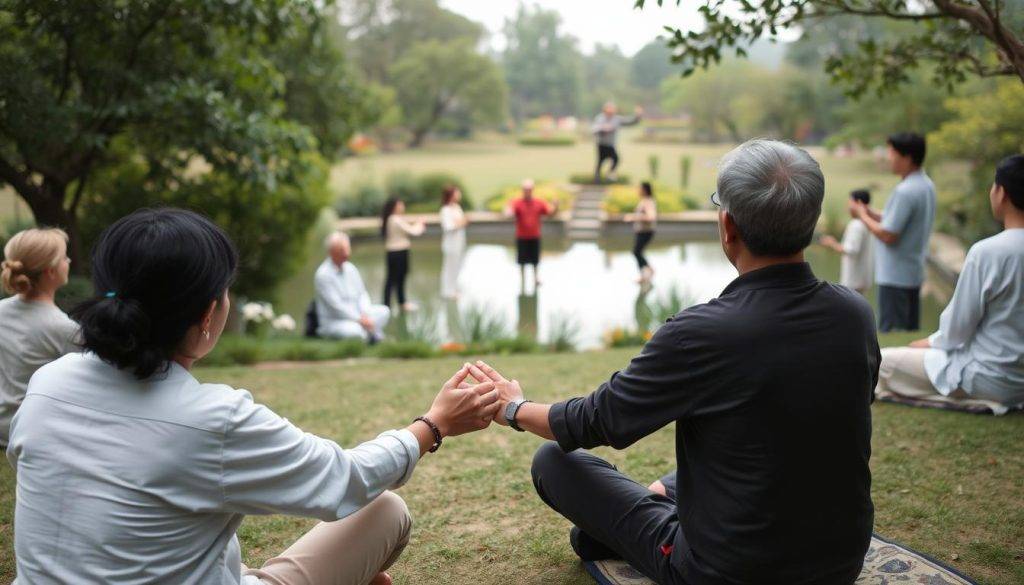“When dealing with people, remember you are not dealing with creatures of logic, but creatures of emotion.” – Dale Carnegie’s timeless words capture the essence of navigating human interactions. This principle lies at the heart of nunchi, a practice that transforms social awareness into an art form.
Often described as the “art of understanding what people think and feel,” this skill goes beyond basic emotional intelligence. Rooted in centuries of tradition, it emphasizes reading unspoken cues – from subtle shifts in tone to group dynamics – to foster harmony. Euny Hong’s book, The Power of Nunchi, reveals how this “eye-measure” technique remains vital in modern life.
Mastering these principles helps you decode rooms instantly, whether in boardrooms or casual gatherings. Imagine sensing tensions before they escalate or recognizing opportunities others miss. Hong’s work shows how refining this ability creates stronger connections and smoother collaborations.
Key Takeaways
- A centuries-old practice focused on interpreting social cues and emotional undercurrents
- Combines cultural wisdom with practical applications for modern relationships
- Euny Hong’s research demonstrates its power in professional and personal settings
- Enhances ability to anticipate needs and resolve conflicts proactively
- Builds foundational skills for cross-cultural communication and leadership
Understanding Korean Nunchi: Definition, History, and Cultural Context
The term nunchi translates literally to “eye-measure”—a concept rooted in observing unspoken dynamics. Historical records trace its origins to Confucian teachings during the Joseon Dynasty, where harmony through social awareness became a cornerstone of etiquette. Over centuries, this practice evolved into a cultural compass guiding interactions across all levels of society.

Origins and Evolution
Early texts from 15th-century South Korea highlight the importance of “reading the room” to maintain group cohesion. Scholar Euny Hong notes in her research that this skill wasn’t just about politeness—it was survival in hierarchical communities. By the 20th century, it became embedded in education, with children learning to interpret tone shifts and body language as early as elementary school.
Cultural Significance Today
Modern culture in South Korea treats this ability as social currency. Hong emphasizes its role in building relationships that balance respect and intuition. For instance, business meetings often prioritize gauging collective moods before decision-making. This cultural reflex reduces conflicts and accelerates consensus.
Schools teach students to hone their “eye-measure” through group activities, reinforcing its value in teamwork. As Hong explains, mastering this concept creates a framework for navigating both personal and professional landscapes—a testament to its enduring relevance.
The Art of Reading Social Cues Through Subtle Observations
Mastering social awareness begins with noticing what remains unsaid. The ability to interpret silent signals shapes how we connect with others—a skill refined through intentional observation. This practice turns everyday interactions into opportunities for deeper understanding.

Interpreting Body Language and Nonverbal Signals
Over 70% of communication happens without words. A clenched jaw, crossed arms, or fleeting eye contact often reveal more than spoken statements. To read a room effectively:
- Focus on clusters of gestures rather than isolated movements
- Notice mismatches between tone and facial expressions
- Track changes in posture during conversations
For example, someone leaning forward while glancing at the door might signal divided attention. Recognizing these patterns helps adjust your approach in real time.
| Signal | Common Meaning | Action Tip |
|---|---|---|
| Frequent clock-checking | Time pressure or disinterest | Shorten your points |
| Mirrored posture | Rapport building | Maintain engagement |
| Tensed shoulders | Stress or disagreement | Address concerns gently |
Recognizing Hierarchies in Group Settings
Every group has invisible power structures. Observe who others glance at before speaking—often a sign of informal leadership. In meetings, the first person to break awkward silences usually holds influence.
Practical ways to map dynamics:
- Track seating arrangements (central positions often denote authority)
- Note whose ideas get repeated versus ignored
- Watch for subtle deference in body language
These insights help navigate professional situations while respecting unspoken rules. When you keep reading these cues, you position yourself to build trust within any team.
Modern Applications of Korean Nunchi in Everyday Situations
Imagine entering a networking event where you instantly sense who needs support or which conversations require a strategic exit. This awareness transforms social interactions from guessing games into opportunities for meaningful connection.

Real-World Strategies for Harmonious Interactions
Consider a team meeting where tension arises. Instead of reacting impulsively, observe subtle cues: slumped shoulders, diverted eye contact, or abrupt silences. Euny Hong suggests using this data to adjust your approach—perhaps shifting topics or inviting quieter members to share.
Three ways to apply these principles:
- Prevent awkward moments: Notice when others feel unheard during group discussions. Paraphrase their points to validate contributions
- Build rapport: Mirror body language subtly during one-on-one chats to create comfort
- Avoid misunderstandings: If someone repeatedly checks their phone, offer to continue the conversation later
In workplace social situations, this skill helps identify unspoken concerns before they escalate. A manager might notice a team member’s hesitant tone and privately address potential issues—turning potential faux pas into trust-building moments.
Hong’s research reveals how refining these abilities contributes to secret happiness success. By making others feel valued through attentive listening, you cultivate relationships that fuel both personal joy and professional growth.
Korean Nunchi’s Role in Building Relationships and Maintaining Harmony
Trust forms the bedrock of meaningful connections, yet its construction often relies on invisible blueprints. Observational mastery shapes interactions that transcend surface-level exchanges, creating bonds strengthened by attentiveness to unspoken needs.

Establishing Trust in Social Interactions
Consider group dinners where seasoned practitioners instinctively refill others’ glasses before requests arise. This proactive awareness—power nunchi in action—builds reliability over years. Colleagues notice who remembers dietary preferences or adjusts conversation topics when tensions surface.
Key trust-building strategies:
- Anticipate needs through pattern recognition (e.g., offering agendas before meetings)
- Resolve conflicts by addressing concerns hinted through hesitant speech
- Strengthen friendships by recalling meaningful details shared months prior
| Situation | Subtle Cue | Trust-Building Response |
|---|---|---|
| Team brainstorming | Silent member gripping notebook | “Jenna, your perspective would add depth” |
| Family gathering | Elder glancing at empty teacup | Warmly offering a refill |
| Client meeting | Tapping pen during proposal | Pausing to address unspoken concerns |
Nurturing Group Cohesion and Mutual Respect
Workplace teams thrive when members honor age-based hierarchies without stifling innovation. Junior staff might frame suggestions as “building on seniors’ expertise,” while leaders create space for diverse voices. This balance mirrors the art of working with people’s thoughts described in cultural studies.
Three cohesion enhancers:
- Rotate leadership roles in projects to validate multiple strengths
- Celebrate collective wins more vigorously than individual achievements
- Address friction points privately to preserve group dignity
These approaches transform gatherings into ecosystems where quality interactions flourish naturally. When members feel understood, collaboration becomes less about managing things and more about shared growth.
Navigating Social Dynamics: Mastering the Power of Nunchi
In a world where interactions unfold at lightning speed, the ability to decode social energy becomes a modern-day superpower. Euny Hong’s research in The Power of Nunchi reveals how this skill transforms workplaces and personal relationships by turning subtle cues into actionable data.

Developing Quick Social Insight for Success
Sharpening this sense starts with treating observations like a language. Notice micro-expressions during team meetings—a raised eyebrow might signal skepticism. Track how often colleagues say “yes” while shaking their heads. These mismatches reveal hidden reservations.
Three ways to build rapid awareness:
- Scan rooms for dominant colors in outfits—groups wearing similar tones often share unspoken bonds
- Time responses in conversations: delayed answers may indicate discomfort
- Note recurring phrases that hint at priorities (“efficiency” vs “creativity”)
Hong describes this practice as “mental muscle memory” that grows stronger with daily use. Over time, you’ll navigate complex work environments with the precision of a seasoned diplomat.
Avoiding Communication Breakdowns
Common missteps often stem from misread energy. A client’s sudden silence after a proposal might signal confusion rather than approval. To prevent friction:
- Pause for three seconds before responding to heated comments
- Match your speaking pace to others’ breathing patterns
- Watch for hidden smiles—lip corners tightening often mask frustration
This data-driven approach creates happier interactions by honoring unspoken needs. As Hong notes, “The most successful people view social spaces as puzzles waiting to be solved—not obstacles to endure.”
Conclusion
Social intuition shapes lives in ways words alone cannot capture. As author Euny Hong demonstrates, mastering this skill unlocks what many call the “secret happiness”—a blend of professional success and personal fulfillment rooted in mindful connection.
Centuries of cultural wisdom prove that observing unspoken dynamics transforms how we engage with the world. From resolving workplace tensions to nurturing friendships, these principles help individuals create harmony where others see chaos. Historical examples show its role in societal progress, while modern applications reveal its power to elevate daily life.
Start small: notice a colleague’s hesitant pause before meetings or a loved one’s fleeting expression. Each observation sharpens your ability to navigate complex social environments with grace. This practice isn’t about perfection—it’s progress toward deeper understanding.
Let this content inspire your next step. Keep refining your awareness, one interaction at a time. The mind that learns to see beyond words discovers opportunities hidden in plain sight—and a richer, more connected way of living.
FAQ
What exactly is the concept behind this social awareness practice?
It’s the art of intuitively understanding group dynamics by observing subtle cues like tone shifts, body language, and unspoken hierarchies. This skill helps individuals adapt quickly to social situations without explicit communication.
How does this approach help in group settings?
By recognizing power structures and emotional undercurrents, it enables smoother collaboration. People who master this avoid overstepping boundaries while fostering mutual respect—critical for maintaining harmony in teams or social circles.
Is this different from emotional intelligence?
While both involve social perception, this practice emphasizes real-time situational analysis. It focuses on immediate environmental cues—like a colleague’s hesitation or a friend’s guarded posture—to guide interactions, blending cultural wisdom with behavioral psychology.
Can outsiders learn to develop this ability effectively?
Absolutely. Like any skill, it improves with intentional observation. Start by practicing active listening, noting how others respond to silence, and studying group hierarchies before contributing. Euny Hong’s book *The Power of Nunchi* offers actionable frameworks for beginners.
What common mistakes do people make when applying these principles?
Overinterpreting signals or prioritizing speed over accuracy leads to errors. For example, misreading polite silence as agreement can backfire. Successful practitioners balance patience with proactive adjustments to shifting dynamics.
How is this relevant in professional environments today?
Modern workplaces thrive on collaboration and cultural sensitivity. Mastering these observational skills helps bridge communication gaps, resolve conflicts preemptively, and build trust—especially in multicultural teams or client-facing roles.
Why is this considered a cornerstone of social success in its culture of origin?
In contexts where indirect communication prevails, the ability to “read the room” reduces friction and preserves relationships. It reflects respect for collective harmony—a value deeply embedded in societal norms and interpersonal interactions.




























































